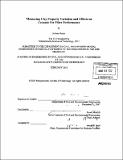Measuring clay property variation and effects on ceramic pot filter performance
Author(s)
Hester, Joshua C. (Joshua Colón)
DownloadFull printable version (18.68Mb)
Other Contributors
Massachusetts Institute of Technology. Dept. of Civil and Environmental Engineering.
Advisor
Susan Murcott.
Terms of use
Metadata
Show full item recordAbstract
Pure Home Water (PHW) is a non-profit organization in Ghana whose mission is to provide safe drinking water to Ghana's Northern Region - the poorest part of the country. Originally a distributor of ceramic pot filters (CPFs) manufactured in Accra, PHW began construction of a new factory outside of Tamale in late 2009 when it was recognized that importing filters from Accra was too inefficient to meet the demands for household water treatment and safe storage. One aspect of CPF manufacturing that has a significant impact on the quality of the finished product is the clay "recipe." In 2010, Reed Miller and Travis Watters conducted research to determine the optimal ratio of combustible material to clay that would yield filters with suitable flow rates, water quality, and strength. However, until 2011, limited research was done on the clay itself, and the relationship between clay properties and PHW filter performance was largely unexplored. Clay has been harvested from a site in Gbalahi, 1 mile away from the PHW factory. Since PHW's acquisition of a second clay source in Wayamba, it has become important to determine to what extent the clays from the two sites are different, as well as which clay properties have the largest impact on quality filter production. To answer these questions, the author measured the plasticity and particle size distribution of 12 clay samples collected from each site. Filters were made from each sample and their performance evaluated based on removal of turbidity, coliform, and E. coli. Statistical analyses were conducted to determine the significance of the observed differences between and relationships among the measured parameters. The Gbalahi clay was found to be more plastic and have a higher clay content (less sand and silt), and filters made from this clay had lower flow rates and better turbidity removal.
Description
Thesis (M. Eng.)--Massachusetts Institute of Technology, Dept. of Civil and Environmental Engineering, February 2012. Cataloged from PDF version of thesis. Includes bibliographical references (p. 69-70).
Date issued
2012Department
Massachusetts Institute of Technology. Department of Civil and Environmental EngineeringPublisher
Massachusetts Institute of Technology
Keywords
Civil and Environmental Engineering.